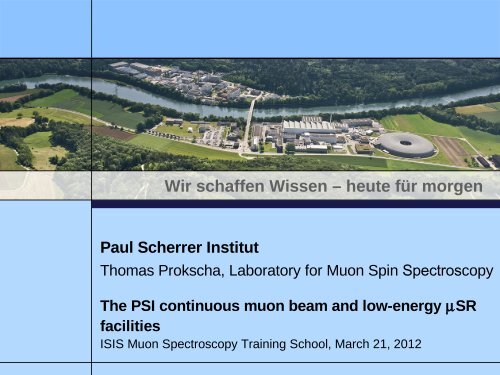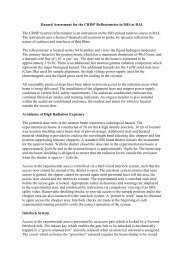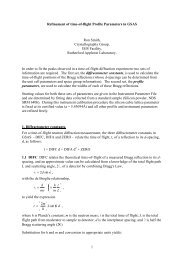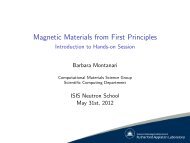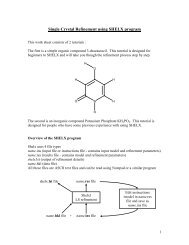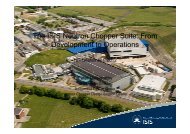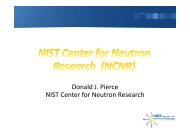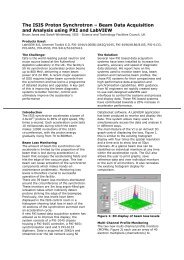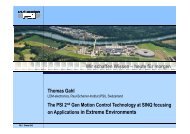PSI Muons - ISIS
PSI Muons - ISIS
PSI Muons - ISIS
You also want an ePaper? Increase the reach of your titles
YUMPU automatically turns print PDFs into web optimized ePapers that Google loves.
Wir schaffen Wissen – heute für morgen<br />
Paul Scherrer Institut<br />
Thomas Prokscha, Laboratory for Muon Spin Spectroscopy<br />
The <strong>PSI</strong> continuous muon beam and low-energy µSR<br />
facilities<br />
<strong>ISIS</strong> Muon Spectroscopy Training School, March 21, 2012
RAL/<strong>ISIS</strong><br />
<strong>PSI</strong>
n SINQ<br />
SwissFEL<br />
µSµS<br />
γ SLS
<strong>PSI</strong> proton accelerator complex<br />
Dolly, µSR,<br />
GPS clone<br />
SINQ, neutron spallation source<br />
Low-energy muon beam<br />
facility (1-30 keV), LEM<br />
GPD, high pressure µSR<br />
High-Field (9.5 T, 20 mK) µSR, 2013<br />
GPS/LTF, general purpose and<br />
low T (20 mK) µSR facility<br />
Ultra-cold<br />
neutrons UCN<br />
50 MHz proton cyclotron, 2.2 mA, 590 MeV, 1.3 MW<br />
beam power (2.4 mA, 1.4 MW test operation);<br />
most powerful cyclotron worldwide and most<br />
intense muon beams (quasi-continuous);<br />
proton therapy,<br />
irradiation facility<br />
Comet cyclotron (superconducting),<br />
250 MeV, 500 nA, 72.8 MHz
The <strong>PSI</strong> isochronous cyclotron<br />
2.2 mA: ~1.4 x 10 16 protons/sec @ 590 MeV (1.3 MW on 5x5 mm 2 = 50 kW/mm 2 ,<br />
stainless steel melts in ~0.1 ms; electric power demand of 1000 households)<br />
A MW proton beam allows to generate 100% polarized 4-MeV µ + beams with<br />
rates >10 8 /sec<br />
Larmor frequency of protons: q/(2πm) = 15.25 MHz/T<br />
ν 0<br />
= q/(2πγm)∙B, γ = E tot<br />
/mc 2<br />
ν rf<br />
= n∙ν 0<br />
, frequency of accelerating radio-frequency<br />
Isochronous cyclotron: B 0<br />
(R) ~ γ(R), constant ν rf<br />
!<br />
<strong>PSI</strong> cyclotron: B 0<br />
= 0.554 T, ν 0<br />
= 8.45 MHz, n = 6,<br />
→ ν rf<br />
= 50.7 MHz
Jess Brewer, UBC & TRIUMF:<br />
“Decay” and “Surface” muon beams
<strong>PSI</strong> muon beam time structure<br />
Pion decay time of 26 ns is “smearing” the<br />
proton beam structure in the muon beam.<br />
This results in a “continuous” muon beam.<br />
A µ + rate R of 10 5 /s means: average time<br />
between to µ + is 1/R = 10 µs.<br />
Probability p to have the next µ + at time t:<br />
p = 1 – exp(-Rt) (“pile-up”)<br />
Single µ + can be detected with very good<br />
time resolution (< 1ns), compared to a<br />
bunch width of 50-100 ns at pulsed beams.<br />
--> measurement of GHz frequencies and<br />
fast relaxation rates (>100 µs -1 ). But “accidental”<br />
background in µ-decay histograms.
Continuous beam µSR experiment<br />
ω = γ · Β ( γ = 1 3 5 . 5 M H z / T )<br />
µ µ µ µ<br />
P ( t = 0 )<br />
P ( t )<br />
s e +<br />
µ<br />
p µ<br />
µ + M y o n -<br />
C o u n t e r<br />
P o s i t r o n - S a m p l e<br />
P o s i t r o n -<br />
C o u n t e r<br />
C o u n t e r<br />
B e x t<br />
Accepted rate as a function of µ rate
Continuous versus pulsed muon beams<br />
● time resolution ≤ 1 ns, ν > 100 MHz<br />
● fast depolarization observable<br />
( >> 10 µs -1 )<br />
Observable asymmetry as a function of<br />
time resolution σ t<br />
:<br />
A(ω) = A 0<br />
x exp(-ω 2 σ t2<br />
/2)<br />
● no segmentation/position<br />
information for e + necessary<br />
● start counter needed<br />
● random background (can be reduced<br />
by „<strong>Muons</strong> On REquest“, MORE)<br />
● limited time window<br />
● separator required for surface muons
µSR instruments at <strong>PSI</strong><br />
● GPS: General Purpose Surface muon instrument; πM3 permanent installation, shared<br />
with LTF; 4 MeV µ + , Separator/Spin Rotator (6 – 60 o ); 0 – 0.6 T, 1.8 – 1000 K;<br />
<strong>Muons</strong> On REquest (MORE).<br />
● LTF: Low Temperature Facility; πM3 permanent installation, shared with GPS;<br />
0 – 3 T, 0.01 K – 10 K.<br />
● Dolly: GPS „clone“; πE1 permanent installation in 2012; 4 MeV µ + ;<br />
Separator/Spin Rotator (6 – 45 o ); 0 – 0.5 T; 0.3 – 300 K.<br />
● GPD: General Purpose Decay channel instrument; µE1 beam; 15 – 60 MeV µ + and µ - ;<br />
0 – 0.65 T, 0.3 – 500 K; high pressure up to 26 kbar.<br />
● ALC: Avoided Level Crossing instrument; 4 MeV µ + ; 0 – 5 T. Not in operation.<br />
● High-Field µSR: πE3 permanent installation; 4 MeV µ + ; 2 Spin Rotators (0 – 90 o );<br />
0.1 – 9.5 T; 0.02 – 300 K.<br />
● LEM: Low Energy Muon beam & µSR instrument; µE4 beam; 1 – 30 keV µ +<br />
(controllable implantation depth 5 – 300 nm), 0 – 0.3 T, 2.3 – 320 K.
● GPS “tells” kicker to send a muon to GPS<br />
● If a muon is detected in GPS “tell”<br />
kicker to send the beam to LTF<br />
● no random beam background in GPS<br />
<strong>Muons</strong> On Request (MORE)<br />
● if decay e + is detected in GPS the<br />
next muon is requested from the kicker<br />
Kicker (two electrodes, +-5kV)<br />
“normal” MORE pulsed<br />
B 0<br />
/N 0<br />
[10 -5 ] 660 9 1<br />
∆t [ns]
MORE example: UPt 3<br />
MORE opens the possibility<br />
● of studying slow relaxation phenomena<br />
at high magnetic fields<br />
● to resolve close spin-precession frequencies<br />
In UPt 3<br />
: 2 Knight shift components, very close<br />
Dramatic and opposite T dependence around<br />
T N<br />
(6K).<br />
UPt 3<br />
is intrinsically inhomogenous.<br />
A. Yaouanc et al, PRL84, 2702 (2000).
The new high-field µSR facility at SµS<br />
Beamline: surface muon beam Δp/p < 5% FWHM: πE3<br />
90° spin rotation!<br />
Magnet: max. field ~10 T, homogeneity: 10 ppm, field drift < 1 ppm/hr.<br />
ν µ<br />
~1.35 GHz<br />
σ < 0.1 µs -1 @ 10 T<br />
Detector system: time resolution δt < 140 ps (RMS) for TF<br />
Sample Environment: 2 K cryostat & DR, with integrated ‘Veto’<br />
system<br />
Difficulties: charged particles with finite momentum distribution<br />
(spiraling radius of 30 MeV positron: 1 cm in 10 T)
Detector dimensions for a 10 T spectrometer<br />
e + Sample<br />
ν<br />
ø<br />
Scintillators<br />
µ +<br />
Veto<br />
counter<br />
ν<br />
60<br />
50<br />
40<br />
30<br />
20<br />
10<br />
Muon<br />
counter<br />
0<br />
10 20 30 40 50 60<br />
Ø (mm) N A F<br />
14 36’400 0.31 ± 0.01 59.1<br />
20 30’800 0.33 ± 0.01 57.9<br />
24 26’300 0.34 ± 0.01 55.1<br />
30 19’900 0.39 ± 0.01 55.0<br />
40 12’000 0.41 ± 0.01 44.9<br />
50 7’300 0.41 ± 0.01 35.0<br />
60 4’400 0.29 ± 0.01 19.1
Oxford Instrument 8/9.5 T<br />
Recondensing System
BF-H400<br />
0.01 – 4 K
Commissioning 2012, user operation 2013
Range of muons in matter<br />
mm<br />
1<br />
Range<br />
µm<br />
10 2<br />
10<br />
1<br />
10 2<br />
Cu<br />
thin films,<br />
multilayers..<br />
bulk<br />
“Surface <strong>Muons</strong>” from π +<br />
decay at rest ( ~ 4 MeV)<br />
generally used for bulk<br />
studies: no depth resolution<br />
nm<br />
10<br />
1<br />
1<br />
10 10 2<br />
10 3<br />
Energy [keV]<br />
10 4<br />
“Low-energy muons”: 0.5 – 30 keV<br />
Allows depth-dependent µSR investigations ( ~ 1 – 300 nm)<br />
Extends the use of µSR to new objects of investigtions<br />
New magnetic/spin probe for thin films, multilayers, surface regions, buried layers
Implantation Profiles of Low Energy <strong>Muons</strong><br />
nm<br />
200<br />
150<br />
Range<br />
Variance<br />
Stopping profiles calculated with Monte<br />
Carlo code Trim.SP by W. Eckstein, MPI<br />
Garching, Germany.<br />
100<br />
50<br />
YBa 2<br />
Cu 3<br />
O 7<br />
0<br />
0 5 10 15 20 25 30 35<br />
Energy [keV]<br />
Experimentally tested for muons:<br />
E. Morenzoni, H. Glückler, T. Prokscha, R.<br />
Khasanov, H. Luetkens, M. Birke, E. M.<br />
Forgan, Ch. Niedermayer, M. Pleines,<br />
NIM B192, 254 (2002).<br />
Stopping Density<br />
0,05<br />
0,04<br />
0,03<br />
0,02<br />
0,01<br />
3.4 keV<br />
6.9 keV<br />
YBa 2<br />
Cu 3<br />
O 7<br />
15.9 keV<br />
20.9 keV<br />
24.9 keV<br />
29.4 keV<br />
0,00<br />
0 50 100 150 200<br />
Depth [nm]
Generation of thermal µ + at a pulsed muon beam<br />
Pulsed beam (25Hz) @ RIKEN-RAL:<br />
P. Bakule,Y.Matsuda,Y.Miyake, K.<br />
Nagamine, M. Iwasaki, Y. Ikedo, K.<br />
Shimomura, P. Strasser, S. Makimura<br />
Nucl. Instr Meth. B 266, 335 (2008)<br />
Intensity: ~15 LE-µ + /sec<br />
Polarization: ~ 50%<br />
Beam spot: 4 mm
Generation of polarized epithermal muons<br />
„Surface“ <strong>Muons</strong><br />
~ 4 MeV<br />
~ 100% polarized<br />
Energy spectrum after a degrader<br />
Solid line: muon energy spectrum<br />
Solid circles: energy spectrum of muonium<br />
~100 µm Ag<br />
Using a proper moderator:<br />
motivated by experiments for<br />
positron moderation, a solid<br />
film of a rare-gas should work! T. Prokscha et al., Phys. Rev. A58, 3739 (1998).
„Surface“ <strong>Muons</strong><br />
~ 4 MeV<br />
~ 100% polarized<br />
Generation of polarized epithermal muons<br />
~100 µm Ag ~500 nm<br />
6 K<br />
s-Ne, Ar,<br />
s-N 2<br />
motivated by<br />
experiments for<br />
positron moderation<br />
T. Prokscha et al., Appl. Surf. Sci. 172, 235 (2001).<br />
T. Prokscha et al., Phys. Rev. A58, 3739 (1998).<br />
E. Morenzoni et al,. J. Appl. Phys. 81, 3340 (1997).<br />
D. Harshmann et al., Phys. Rev. B36, 8850 (1987).
Characteristics of epithermal muons<br />
L<br />
A s y m m e t r y<br />
AP(t)<br />
P(0) ≅1<br />
E. Morenzoni, T. Prokscha, A. Suter, H. Luetkens, R.<br />
Khasanov, J.Phys.: Cond. Matt. 16, S4583 (2004).<br />
T i m e [ µ s ]<br />
E. Morenzoni, F. Kottmann, D. Maden, B. Matthias, M. Meyberg,<br />
T. Prokscha, T. Wutzke, U. Zimmermann, PRL 72, 2793 (1994).<br />
suppression of electronic energy loss for E > E g<br />
, large band gap E g<br />
(10-20 eV) „soft, perfect“<br />
insulators<br />
large escape depth L (10-100 nm), no loss of polarization during moderation (~10 ps)<br />
moderation efficiency is low (requires high intensity µ + beam, > 10 8 µ + /s):<br />
-4<br />
ε µ+<br />
= N epith<br />
/N 4MeV<br />
≈ ∆Ω (1-F Mu<br />
) L/∆R ≈ 0.25 L/ ∆R ≈ 10 – 10 -5<br />
∆Ω: probability to escape into vacuum (~50% for isotropic angular distribution)<br />
F Mu<br />
: muonium formation probability<br />
page 28
LE-µ+ Apparatus at µE4 beam line<br />
At 2.2 mA proton current:<br />
~4.6 • 10 8 µ + /s total, ∆p/p = 9.5% (FWHM)<br />
~1.9 • 10 8 µ + /s on LEM moderator<br />
~1.1 • 10 4 µ + /s moderated (solid Ar)<br />
T. Prokscha, E. Morenzoni, K. Deiters, F. Foroughi,<br />
D. George, R. Kobler, A. Suter and V. Vrankovic<br />
Nucl. Instr. Meth. A 595, 317 (2008).
LE-µ + beam and LE-µSR spectrometer<br />
Moderator cryostat<br />
QSM612, last quadrupole of µE4 beam<br />
LE-µSR spectrometer
Low energy µ + beam and set-up for LE-µSR<br />
- UHV system, 10 -10 mbar<br />
- some parts LN 2<br />
cooled<br />
~1.9 •10 8 µ + /s<br />
rebuilt µE4 beam line<br />
Polarized Low Energy Muon<br />
Beam<br />
Energy: 0.5-30 keV<br />
∆E, ∆t: 400 eV, 5 ns<br />
Depth: 1 – 300 nm<br />
Polarization ~100 %<br />
Beam Spot: 12 mm (FWHM)<br />
~ 11000 µ + /s; accelerate<br />
up to 20 keV<br />
up to ~ 4500 µ + /s<br />
T = 2.5 – 320 K<br />
B = 0 – 0.3 T ┴ , 0 – 0.03 T ║ sample surface<br />
page 31
Low energy µ + beam and set-up for LE-µSR<br />
• UHV:<br />
p ∼ 10 -10 mbar<br />
• Electrostatic<br />
accel-decel and<br />
transport system<br />
(LN 2<br />
cooled)<br />
Filter<br />
10-nm-thin C-foil<br />
Source<br />
INPC 2010, July-05 2010<br />
Implantation time<br />
Sample
Depth dependent LE-µSR measurements<br />
July-05 2010 page 33
Magnetic field profiles in superconductors<br />
“ l o c a l ”<br />
Direct, absolute measurement of<br />
magnetic penetration depth<br />
ξ<br />
“ n o n - l o c a l ”<br />
λ(T)<br />
∝<br />
m<br />
n (T)<br />
s<br />
*<br />
effective mass<br />
density of<br />
supercarriers<br />
0<br />
ξ<br />
Direct Test of theories (London, BCS)<br />
z<br />
−<br />
λab<br />
(T)<br />
→ B(z) = B0e<br />
λ<br />
z<br />
B(z)<br />
Local, non-local response<br />
Determination of the<br />
coherence length ξ, κ=λ/ξ<br />
local<br />
nonlocal<br />
z
Magnetic field profiles in Pb and YBa 2<br />
Cu 3<br />
O 7-δ<br />
0.01<br />
Lead, T c<br />
=7.0(2) K, h ext<br />
= 91.5(3)G,<br />
ξ 0<br />
= 90(5)nm, λ 0<br />
= 58(3)nm<br />
0.01<br />
YBa 2<br />
Cu 3<br />
O 7-δ<br />
, T=20K, T c<br />
=87.5K<br />
h ext<br />
= 91.5(3) G,<br />
ξ 0<br />
= 1.5 nm fixed, λ 0<br />
= 137(10) nm<br />
B (T)<br />
6.66K<br />
B (T)<br />
6.19K<br />
1E-3<br />
1E-3<br />
h ext<br />
exp(-z/λ(T))<br />
3.4 keV<br />
8.9 keV<br />
15.9 keV<br />
20.9 keV<br />
29.4 keV<br />
2.85K<br />
0 50 100 150<br />
z (nm)<br />
Non-local: non- exponential<br />
0 50 100 150<br />
z (nm)<br />
local: exponential<br />
T.J. Jackson et al., Physical Review Letters 84, 4958 (2000).<br />
A. Suter et al., Physical Review Letters 92, 087001 (2004).<br />
A. Suter et al., Physical Review B 72, 024506 (2005).
In-plane Anisotropy in detwinned YBa 2<br />
Cu 3<br />
O 6.92<br />
samples produced by R. Liang,<br />
W. Hardy, D. Bonn, Univ. of<br />
British Columbia<br />
λ(T)<br />
∝<br />
m<br />
n (T)<br />
s<br />
*<br />
effective mass<br />
density of super<br />
carriers<br />
1/λ 2 ~ n s<br />
/m* ≡ ρ s<br />
, superfluid density<br />
Test of theories (London, BCS),<br />
symmetry of the sc gap
Detwinned YBa 2<br />
Cu 3<br />
O 6.92<br />
, T c<br />
= 94.1 K, B = 9.47 mT<br />
100 K<br />
8 K<br />
8 K<br />
λ(T)<br />
∝<br />
m<br />
n (T)<br />
s<br />
*<br />
effective mass<br />
density of super carriers<br />
at low T for a d-wave SC:<br />
λ a<br />
= 126(1.2)nm, λ b<br />
= 105.5(1.0) nm,<br />
λ a<br />
/λ b<br />
= 1.19(1)<br />
R.F. Kiefl et al, PRB 81, 180502(R), (2010)<br />
page 37
Meissner effect in a strongly underdoped cuprate<br />
La 1.84<br />
Sr 0.16<br />
CuO 4<br />
- La 1.94<br />
Sr 0.06<br />
CuO 4<br />
- La 1.84<br />
Sr 0.16<br />
Cu 4<br />
T c<br />
= 32 K<br />
T' c<br />
< 5 K T c<br />
= 32 K<br />
induced superfluid density disappears at T eff<br />
>>T' c<br />
. This<br />
result is not expected within the conventional proximity<br />
effect theory.<br />
E. Morenzoni et al, Nature Communications 2, 272 (2011)
Dimensionality Control of Electronic Phase<br />
Transitions in Nickel-Oxide Superlattices<br />
A.V. Boris et al, Science 332, 937 (2011)<br />
MPI Solid State Research - MPI Metals Research – Univ. Fribourg - <strong>PSI</strong><br />
• 100-nm-thick NxN u.c. LaNiO 3<br />
/LaAlO 3<br />
superlattices<br />
• 2 u.c. LaNiO 3<br />
: MI and AF transitions at T < 150 K<br />
• 4 u.c. LaNiO 3<br />
: metallic and paramagnetic at all T<br />
T MI<br />
T MI
Spatially homogeneous ferromagnetism of (Ga,Mn)As<br />
• Mn-doped GaAs potential ‘spintronics’ material<br />
• great interest in fundamental research: evolution from a<br />
paramagnetic insulator to ferromagnetic metal<br />
• controversy if FM is associated with intrinsic spatial<br />
inhomogeneity<br />
Low-energy µSR (in combination with conductivity and<br />
DC/AC magnetization) results:<br />
• sharp onset of FM order, developing homogeneously in<br />
the full volume fraction, in both insulating and metallic<br />
films.<br />
• smooth evolution of ordered moment size across metalinsulator<br />
transition at x ~ 0.03<br />
• FM coupling between Mn before full emergence of<br />
itinerant hole carriers<br />
muon decay asymmetry (10 mT TF top) and zero<br />
field (ZF) relaxation rate (bottom) as a function of<br />
temperature and doping<br />
S.R. Dunsiger, J.P. Carlo, T. Goko, G. Nieuwenhuys, T. Prokscha, A. Suter, E. Morenzoni, D. Chiba, Y.<br />
Nishitani, F. Matsukara, H. Ohno, J. Ohe, S. Maekawa, Y.J. Uemura, Nature Materials 9, 299 (2010).
Spin diffusion length in organic spin valve<br />
Alq 3<br />
Magnetoresistance vs B<br />
Long coherence time of injected<br />
spins ~10 -5 s measurable<br />
static fields<br />
Spin diffusion length vs T correlates<br />
with magneto-resistance<br />
Field distribution: I on<br />
- I off<br />
Skewness<br />
First direct measurement of<br />
spin diffusion length in a<br />
working spin valve.<br />
A.J. Drew et al., Nature Materials 8, 109 (2009)<br />
INPC 2010, July-05 2010
“Cold” muonium from mesoporous SiO 2<br />
in vacuum<br />
Motivated by recent results on Ps emission from mesoporous SiO 2<br />
films<br />
250 K, 5 keV: 40% emission<br />
of thermal Mu in vacuum<br />
100 K, 5 keV: 20% emission<br />
of thermal Mu in vacuum;<br />
expect 40% at 2 keV (to be<br />
confirmed)<br />
Vacuum Mu fraction F V as a function of<br />
Mu<br />
temperature and energy; solid lines are a<br />
fit of a diffusion model to the data.<br />
A. Antognini, P. Crivelli, T. Prokscha, K.S. Khaw, B. Barbiellini, L. Liszkay, K. Kirch, K. Kwuida, E. Morenzoni,<br />
F.M. Piegsa, Z. Salman, A. Suter, arXiv:1112.4887v1, accepted by PRL (2012)
Some More Low Energy Muon Applications<br />
Surface dynamics of polymers<br />
Magnetic properties of monolayers<br />
of single molecule magnets<br />
Z. Salman et al.<br />
F.L. Pratt et al., PRB 72, 121401(R) (2005)<br />
Formation of hydrogen impurities<br />
in semiconductors at low energies<br />
T. Prokscha et al., PRL 98, 227401 (2007)<br />
T. Prokscha et al., Physcia B 404, 866 (2009)<br />
D.G. Eshchenko et al., Physica B 404, 873 (2009)<br />
H.V. Alberto et al., Physica B 404, 870 (2009)<br />
300μ<br />
Photo-induced<br />
effects in<br />
semiconductors<br />
T. Prokscha et al.<br />
Current effects on magnetism<br />
and superconductivity in a thin<br />
La 1.94<br />
Sr 0.06<br />
CuO 4<br />
wire<br />
M. Shay et al., PRB 80, 144511 (2009)<br />
Superconductivity and<br />
Magnetism in<br />
La 2<br />
CuO 4<br />
/La 1.56<br />
Sr 0.44<br />
CuO 4<br />
Superlattices<br />
T N<br />
A. Suter et al., PRL 106,<br />
T c<br />
237003 (2011)<br />
doping<br />
Superfluid density in high and<br />
low T c<br />
heterostructures<br />
B. Wojek et al., PRB 85, 024505 (2012)<br />
Superconductivity and<br />
magnetism in electron doped<br />
cuprates and pnictide films<br />
H. Luetkens et al.
Developments<br />
• Spin-rotator for LF-µSR, commissioning started in Feb-2012; will give<br />
factor 2 better time resolution (σ ~ 2.5 ns) compared to old setup<br />
• Increasing LEM rate, solid Ne moderator<br />
• A new APD positron spectrometer for the “B-parallel” magnet<br />
• Extension to lower temperatures (from 2.7 K to
LEM spin-rotator for LF-µSR
LEM spin-rotator installation<br />
Jan-17, 2012 Jan-18, 2012<br />
Jan-27, 2012 Feb-27, 2012
LEM spin-rotator (SR): first tests with protons<br />
H + Beamspot at sample position<br />
H 0 energy distribution<br />
H 0 energy distribution<br />
TD<br />
MCP2<br />
Transmission through SR > 90%
LEM group at <strong>PSI</strong><br />
T. Prokscha, H. Saadaoui (MaNEP PostDoc) A. Suter, Z. Salman, H.P.<br />
Weber (technician)<br />
Part time: H. Luetkens, E. Morenzoni<br />
Ph. D. students: G. Pascua (part time), E. Stilp (<strong>PSI</strong>/U Zurich)<br />
Computing support: A. Raselli (part time)<br />
All people of LMU (Laboratory for Muon Spin Spectroscopy):<br />
http://lmu.web.psi.ch/people/people.html


